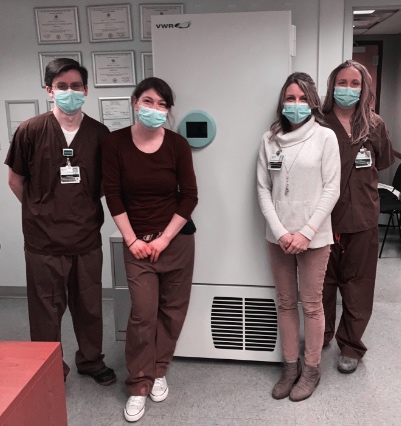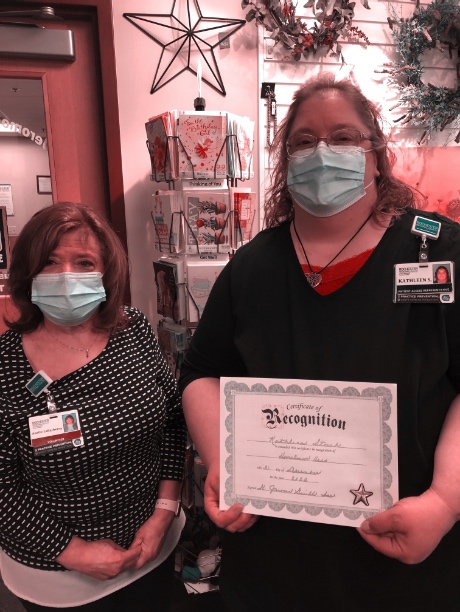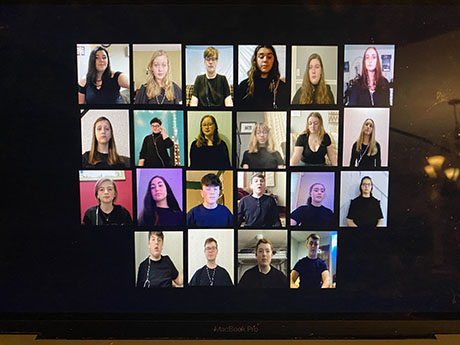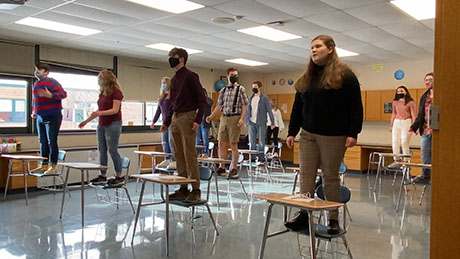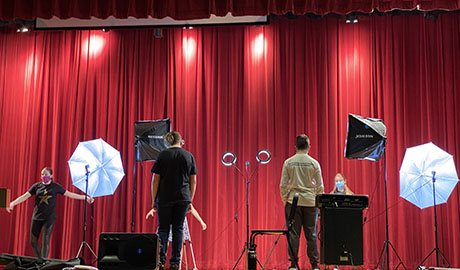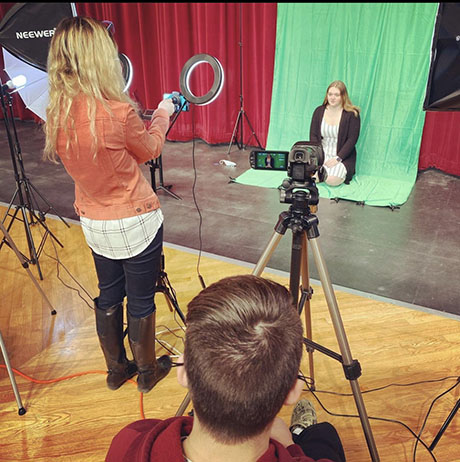A year ago today the first case of COVID-19 was identified in Genesee County and officials at United Memorial Medical Center were already preparing for what was widely feared would be a surge of cases that could overwhelm the hospital system.
The first wave never crested locally in the way it did in New York City or Italy, but the preparation did serve the staff at UMMC well when the second wave hit in December.
It was "all hands on deck," said Dr. Peter Janes, chairman of the Department of Medicine at UMMC and director of the hospitalist group.
'All Hands On Deck'
At the height of the winter surge, when dozens of local residents were hospitalized with COVID-19, every staff member at UMMC was pressed into service. Medical providers affiliated with the hospital assisted. Residents (doctors in training) worked extra hours. Nurses from other departments cared for coronavirus patients.
"The help we got in the second wave was shocking," Janes said. "We doubled our workforce, basically. We tripled our patient population and we at least doubled our workforce. It was just incredible to see. I was just so thankful because I just didn't know.
"I saw the numbers going up -- I'm just like, 'I'm not going to go home. I'm going to be here 24 hours a day. We're going to be sleeping in the hospital.' And people just kept coming in. We got extra people that work nights. I mean, that's amazing. We were able to shift people to do 12-hour overnights.
We got nurse practitioners who were working as nurses on the floors and helping out. Everybody was doing things, even the administration. We had people from the administrative hallway, people who have a background in health care, helping."
That included Dan Ireland, UMMC's president, who started his medical career as an orderly.
"I've seen him put on his scrubs and do some work," Janes said.
Planning for Widespread Contagious Disease
Like a lot of people, early in 2020, Janes saw the news coming out of China of a new SARS (severe acute respiratory syndrome) strain causing hospitalizations and death but thought -- as many people did -- that new viruses come along once in a while and don't cause a pandemic.
Even so, Janes and his colleagues at UMMC and Rochester Regional Health, began to review plans and procedures for dealing with a widespread contagious disease.
"I think initially, we were like, 'oh, here is another story,' " Janes said. "But as it sort of built up, we realized this was going to be something."
Then, during the week of March 11, the whole nation realized at once, SARV-CoV-2 was here and it was serious. The NBA, the NHL, seasons were suspended and spring training was canceled. Colleges and schools started shutting down.
"March 11th was a Wednesday, and I think right around there, that might have been the Sabers' last game, and that's when my daughter was told she's getting school canceled," Janes said. "That was the last in-person meeting I had with Rochester Regional Health, March 11th.
"I was in Rochester and I took my daughter up to Rochester to meet some friends because she was home for college. And after that, I go to pick her up, and there she tells me her college is canceled. And that's the last time I had an in-person meeting in Rochester."
UMMC staff reviewed every part of the hospital in order to plan how best to use the space if there was a surge of patients as well as reviewing personnel rosters.
"In preparing, we went through and with a clipboard and paper looking at all the possible places," Janes said. "We went through and looked at different providers and their skill sets and different nurses and their skill sets and where they could be redeployed to. Then we looked at PPE (personnel protective equipment), saying, you know, 'are we going to have enough of this stuff?'
'It Was Kind of Crazy'
"And again, it was kind of crazy at first because we got a case, we got a couple of cases. then it was a few, or five or six cases, in the first couple of weeks and we're making all these big preparations and we're like is this it? But we knew from what was going on in New York and what was going on out on the West Coast, like in Seattle, we knew it was going to affect us."
Janes said he was always worried more about staffing to deal with a large wave of patients than he was about capacity at the hospital.
"We thought, 'is this going to be wartime medicine?' " Janes said. "Is this going to be like we get people in, we have a different setup. We have wards in different areas and hallways, whatever it is. But I said we can squeeze people in here.
"But if it's as bad as they say it could be, then it's going to be just that bad in Rochester, just that bad in Buffalo. It's going to be the providers, the nurses, the staff, the cleaning crews, the people making lunches and dinners, and everybody here. I'm thinking, manpower is going to be our biggest limiting step."
Early in the pandemic, the big worry was whether there would be enough ventilators to treat the most serious COVID-19 patients. That was why there was a major push -- "two weeks to flatten the curve" -- to slow the spread, to give hospitals time to be able to handle the influx of patients, and ensure there were enough ventilators to treat serious cases.
Treatment Evolves, Scientists Learn More
We did flatten the curve but the treatment of COVID-19 also evolved as doctors and scientists learned more about the new disease.
"During the second surge, we got up there with the ventilators in the system, for sure, we got to a point where we start to get a little nervous again," Janes said. "I think a couple of different approaches, and it's hard to put your finger on exactly what it was, but I think we utilized different medications like Decadron that we started after the hydroxychloroquine didn't really pan out.
"Decadron, and then there's another medicine, Remdesivir, that that may have really cut back on the progression of the disease to the ventilator. But we also early on, there's a question whether BiPAP should work or the high flow oxygen would work. So initially, I think you may be put on a ventilator sooner but now we hold off and get people through it without a ventilator."
The second surge was "pretty darn serious," Janes said, and it came in stages. At first, most of the patients were in their 40s to 60s and primarily had low oxygen levels (hypoxic) and the new treatments were effective with these patients.
In the next stage, nursing homes in the area here getting hit hard by the disease and older people were more frequently the patients being treated at the hospital. UMMC went from seeing an average of 30 to 35 patients per day to more than 80 patients were day.
"We really need people in here. And people came in and it wasn't just the providers, it wasn't just doctors," Janes said. "There were a lot of people who came in and there were nurses working in totally in different areas, our techs acting as aides upstairs, people who you have never seen before but they're all over the place and everybody pitched in. It was pretty amazing to see."
The Pandemic Has Changed Medicine, Maybe Society, Too
The pandemic has changed medicine, Janes said, it has probably also changed society. Certainly, he said, we won't stop wearing masks in some situations anytime soon.
Face coverings, he said, have proven their efficiency at slowing the spread of infectious diseases. The big drop in flu cases this season is one piece of evidence that people wearing masks, washing hands, keeping distance helps stop the spread of viruses.
"I don't see masks going away from health care any anytime soon," Janes said. "I don't see masks going away from Wegmans or Tops anytime soon, but I worry about a little bit about complacency and lack of vaccination. I think we're getting a lot of people vaccinated, but not everybody. And so I think a third surge is very possible (in the fall or winter)."
The one message he wants to leave readers with, though, is "don't neglect your health." People, he said, should not let apprehension about SARS-CoV-2 keep them from seeing their doctors and seeking preventive and ongoing care for their medical conditions and concerns.
"I think people were so scared of the health care system in the spring, they pushed off of their care," Janes said. "And so in the spring, what we found was that you didn't come to the hospital unless you had COVID. People with chest pain and people with infections and people with lots of uncontrolled diabetes or heart failure were staying home and sort of suffering through that.
"And I think that led to a lot of worse outcomes. I want to really encourage people to take care of their health. They can't be scared of the doctor's office. They can't be scared of making a phone call. People have to still reach out to the providers, make sure that they're in contact with their doctors, with their providers."

